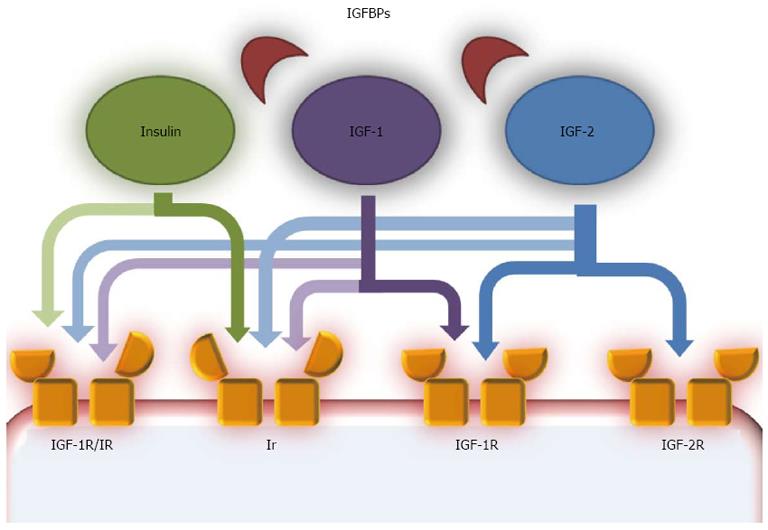Copyright
©2014 Baishideng Publishing Group Inc.
World J Gastroenterol. Jul 28, 2014; 20(28): 9217-9228
Published online Jul 28, 2014. doi: 10.3748/wjg.v20.i28.9217
Published online Jul 28, 2014. doi: 10.3748/wjg.v20.i28.9217
Figure 1 Insulin growth factor pathway scheme.
The insulin-like growth factor (IGF) pathway is composed of several components. IGF ligands are IGF-1 and IGF-2, two peptides that share high similarities with insulin. A family of carrier proteins, called insulin-like growth factor binding proteins (IGFBPs), bind IGF-1 and IGF-2 in the blood. IGF-1 and IGF-2 act as autocrine, paracrine and endocrine growth factors and are mostly produced in the liver, especially IGF-1 in the postnatal era and IGF-2 during fetal development. They can act on various receptors, but have higher affinity with IGF-1R, a tyrosine kinase receptor structurally similar to the insulin receptor (Ir). IGF-1 can also bind Ir, but with lower affinity than IGF-1R, while IGF-2 binds Ir only during fetal development. IGF-2R is structurally similar to IGF-1R, but binds only IGF-2 and most probably acts on this growth hormone with an inhibitory effect, as a clearance site. Another receptor is a hybrid receptor consisting of insulin and IGF-1R hemireceptors which preferentially binds IGF-1, while insulin does not have optimal binding[70].
-
Citation: Scalera A, Tarantino G. Could metabolic syndrome lead to hepatocarcinoma
via non-alcoholic fatty liver disease? World J Gastroenterol 2014; 20(28): 9217-9228 - URL: https://www.wjgnet.com/1007-9327/full/v20/i28/9217.htm
- DOI: https://dx.doi.org/10.3748/wjg.v20.i28.9217









